Tax Rules and Compliance in Nigeria
VerifiedAdded on 2020/04/07
|8
|2436
|200
AI Summary
This assignment delves into the intricacies of tax regulations in Nigeria. It examines key provisions, explores challenges associated with tax compliance, and utilizes case studies to illustrate practical applications. The analysis provides valuable insights into the Nigerian tax landscape.
Contribute Materials
Your contribution can guide someone’s learning journey. Share your
documents today.
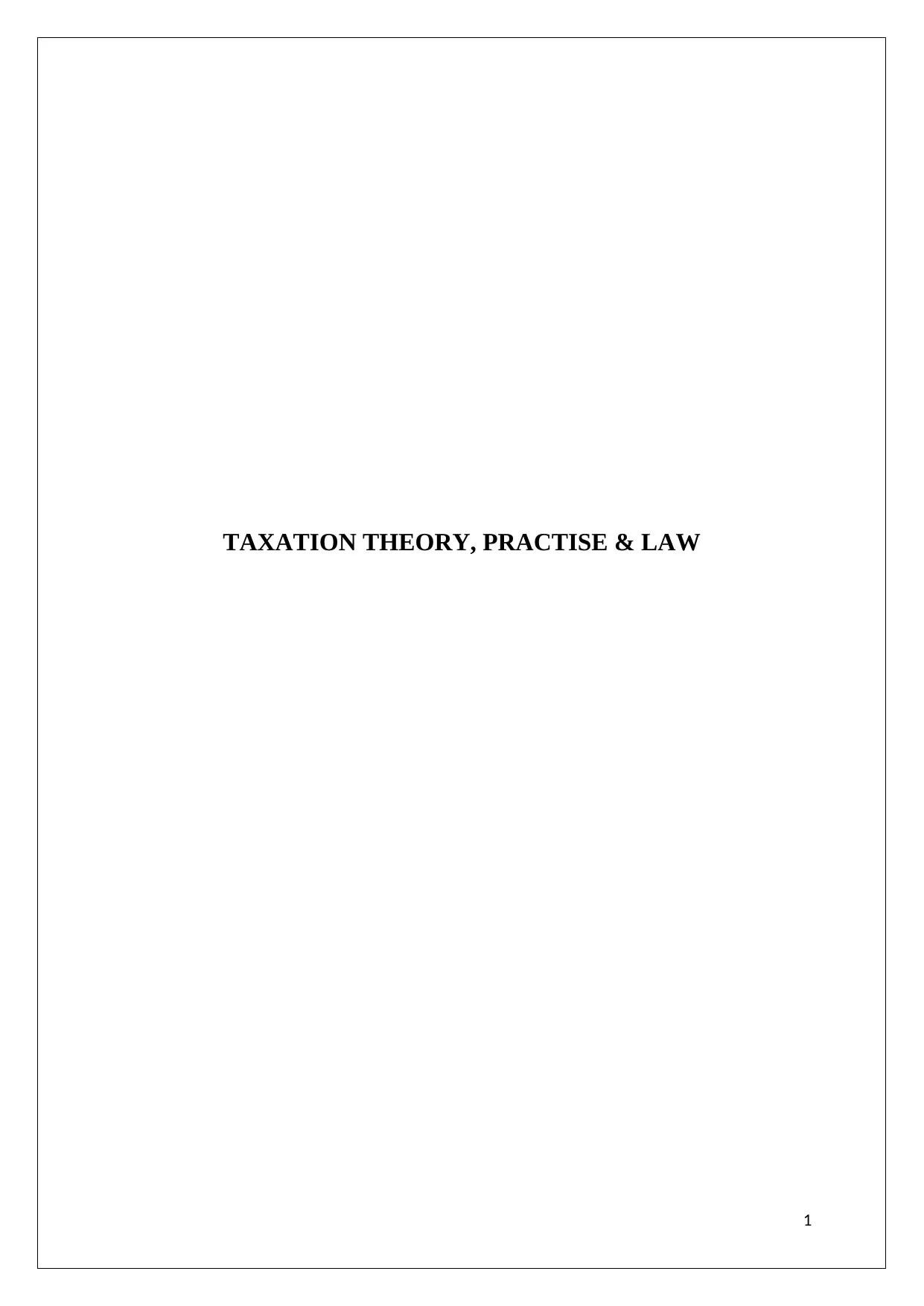
TAXATION THEORY, PRACTISE & LAW
1
1
Secure Best Marks with AI Grader
Need help grading? Try our AI Grader for instant feedback on your assignments.
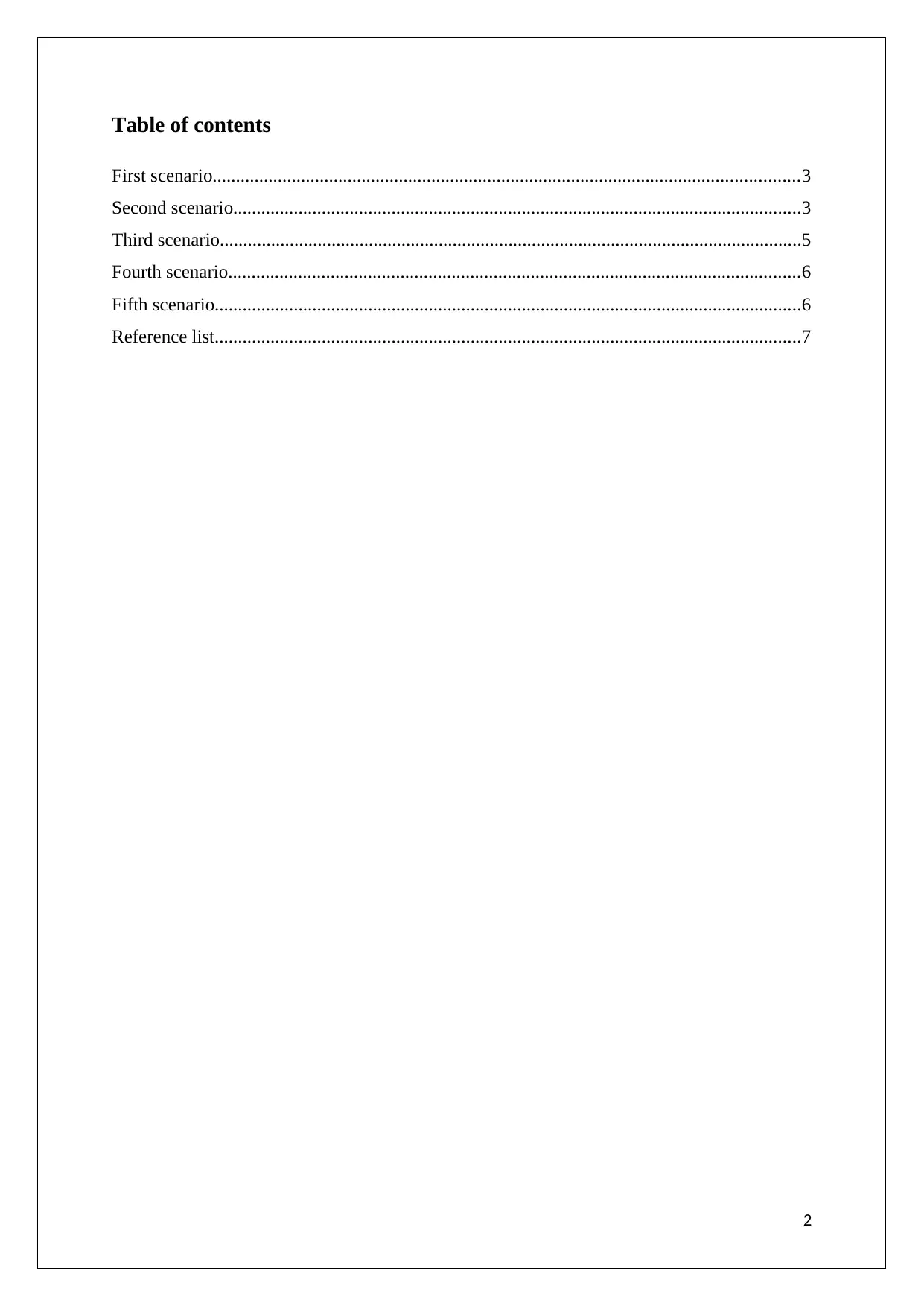
Table of contents
First scenario..............................................................................................................................3
Second scenario..........................................................................................................................3
Third scenario.............................................................................................................................5
Fourth scenario...........................................................................................................................6
Fifth scenario..............................................................................................................................6
Reference list..............................................................................................................................7
2
First scenario..............................................................................................................................3
Second scenario..........................................................................................................................3
Third scenario.............................................................................................................................5
Fourth scenario...........................................................................................................................6
Fifth scenario..............................................................................................................................6
Reference list..............................................................................................................................7
2
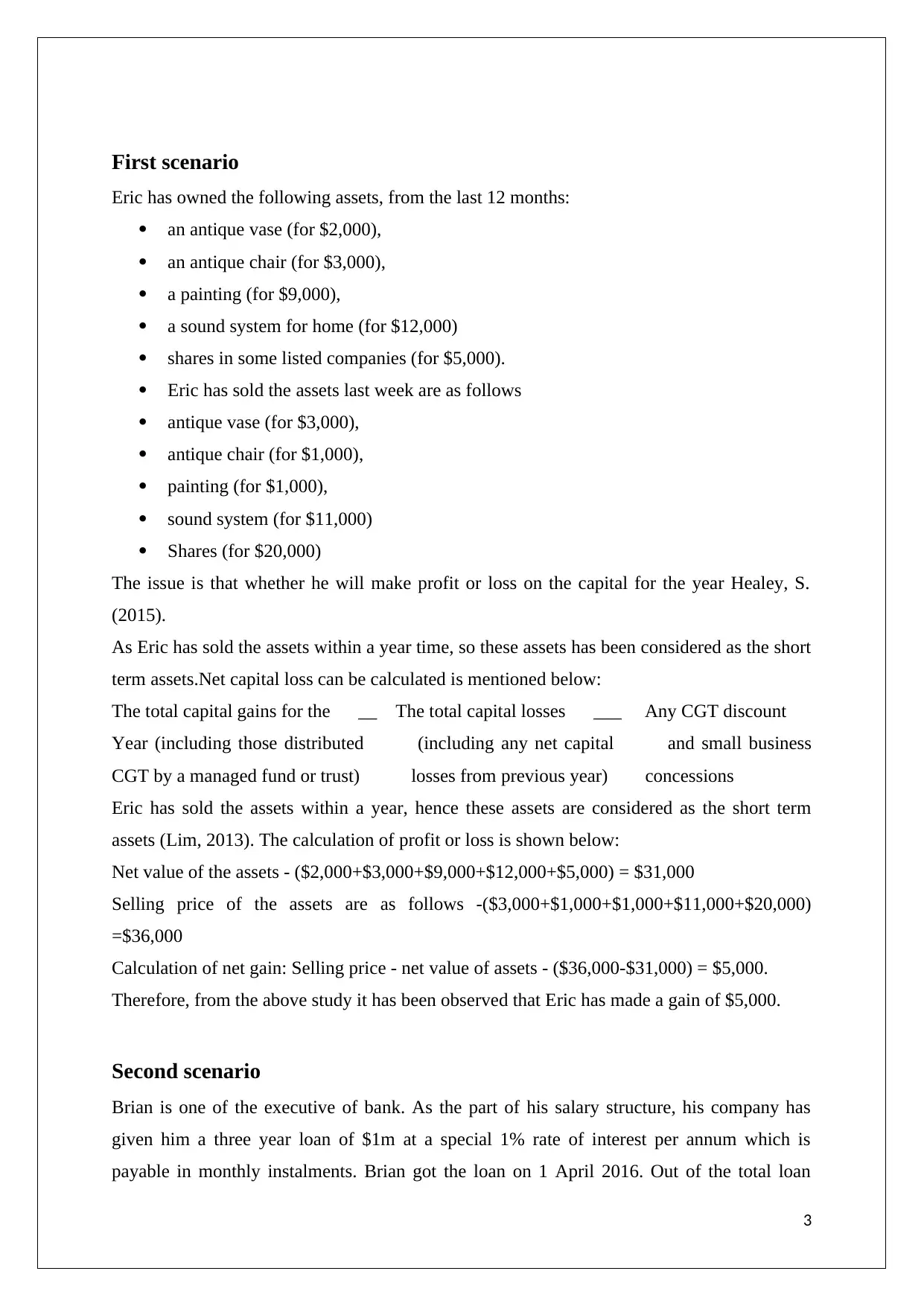
First scenario
Eric has owned the following assets, from the last 12 months:
an antique vase (for $2,000),
an antique chair (for $3,000),
a painting (for $9,000),
a sound system for home (for $12,000)
shares in some listed companies (for $5,000).
Eric has sold the assets last week are as follows
antique vase (for $3,000),
antique chair (for $1,000),
painting (for $1,000),
sound system (for $11,000)
Shares (for $20,000)
The issue is that whether he will make profit or loss on the capital for the year Healey, S.
(2015).
As Eric has sold the assets within a year time, so these assets has been considered as the short
term assets.Net capital loss can be calculated is mentioned below:
The total capital gains for the __ The total capital losses ___ Any CGT discount
Year (including those distributed (including any net capital and small business
CGT by a managed fund or trust) losses from previous year) concessions
Eric has sold the assets within a year, hence these assets are considered as the short term
assets (Lim, 2013). The calculation of profit or loss is shown below:
Net value of the assets - ($2,000+$3,000+$9,000+$12,000+$5,000) = $31,000
Selling price of the assets are as follows -($3,000+$1,000+$1,000+$11,000+$20,000)
=$36,000
Calculation of net gain: Selling price - net value of assets - ($36,000-$31,000) = $5,000.
Therefore, from the above study it has been observed that Eric has made a gain of $5,000.
Second scenario
Brian is one of the executive of bank. As the part of his salary structure, his company has
given him a three year loan of $1m at a special 1% rate of interest per annum which is
payable in monthly instalments. Brian got the loan on 1 April 2016. Out of the total loan
3
Eric has owned the following assets, from the last 12 months:
an antique vase (for $2,000),
an antique chair (for $3,000),
a painting (for $9,000),
a sound system for home (for $12,000)
shares in some listed companies (for $5,000).
Eric has sold the assets last week are as follows
antique vase (for $3,000),
antique chair (for $1,000),
painting (for $1,000),
sound system (for $11,000)
Shares (for $20,000)
The issue is that whether he will make profit or loss on the capital for the year Healey, S.
(2015).
As Eric has sold the assets within a year time, so these assets has been considered as the short
term assets.Net capital loss can be calculated is mentioned below:
The total capital gains for the __ The total capital losses ___ Any CGT discount
Year (including those distributed (including any net capital and small business
CGT by a managed fund or trust) losses from previous year) concessions
Eric has sold the assets within a year, hence these assets are considered as the short term
assets (Lim, 2013). The calculation of profit or loss is shown below:
Net value of the assets - ($2,000+$3,000+$9,000+$12,000+$5,000) = $31,000
Selling price of the assets are as follows -($3,000+$1,000+$1,000+$11,000+$20,000)
=$36,000
Calculation of net gain: Selling price - net value of assets - ($36,000-$31,000) = $5,000.
Therefore, from the above study it has been observed that Eric has made a gain of $5,000.
Second scenario
Brian is one of the executive of bank. As the part of his salary structure, his company has
given him a three year loan of $1m at a special 1% rate of interest per annum which is
payable in monthly instalments. Brian got the loan on 1 April 2016. Out of the total loan
3
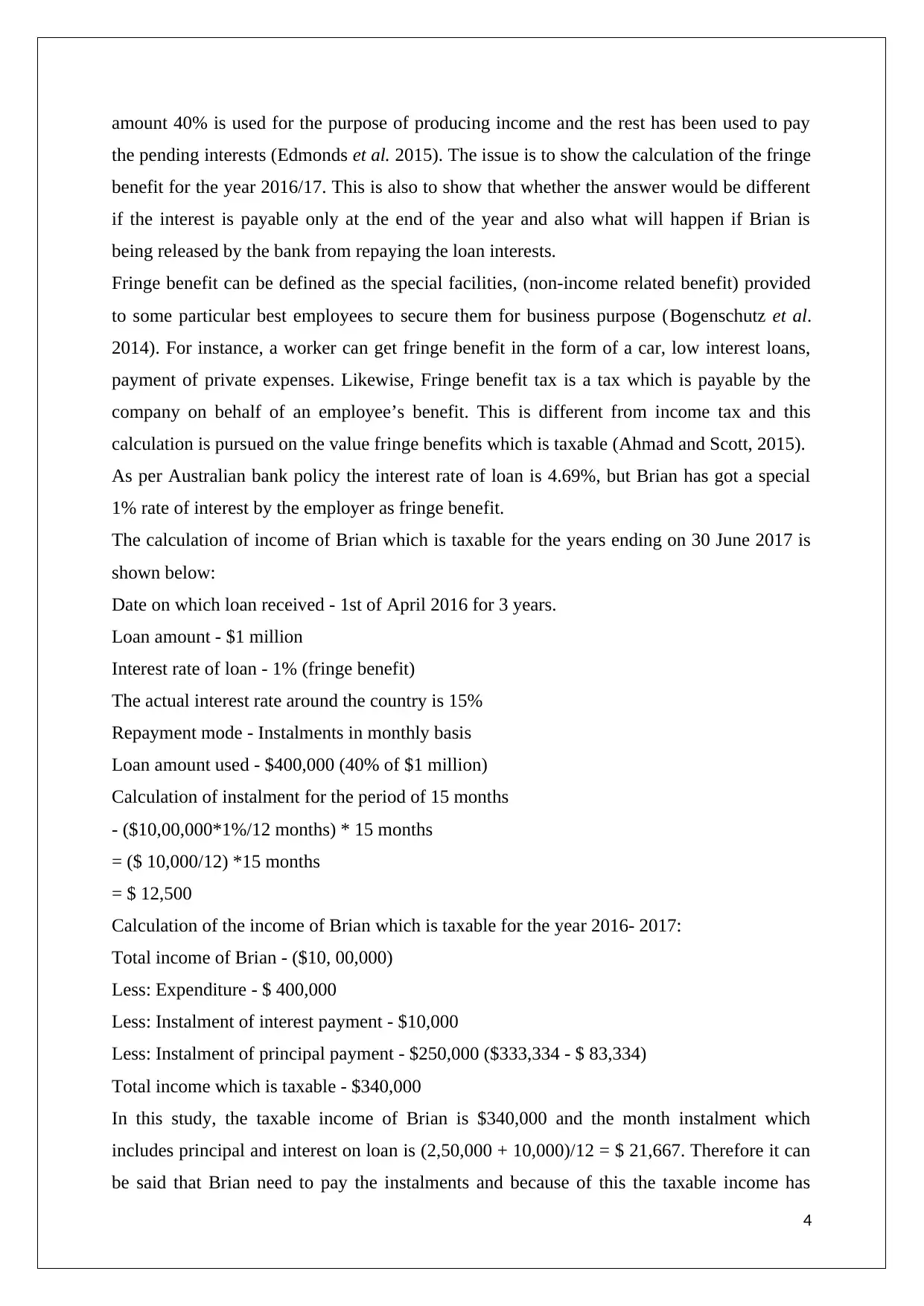
amount 40% is used for the purpose of producing income and the rest has been used to pay
the pending interests (Edmonds et al. 2015). The issue is to show the calculation of the fringe
benefit for the year 2016/17. This is also to show that whether the answer would be different
if the interest is payable only at the end of the year and also what will happen if Brian is
being released by the bank from repaying the loan interests.
Fringe benefit can be defined as the special facilities, (non-income related benefit) provided
to some particular best employees to secure them for business purpose (Bogenschutz et al.
2014). For instance, a worker can get fringe benefit in the form of a car, low interest loans,
payment of private expenses. Likewise, Fringe benefit tax is a tax which is payable by the
company on behalf of an employee’s benefit. This is different from income tax and this
calculation is pursued on the value fringe benefits which is taxable (Ahmad and Scott, 2015).
As per Australian bank policy the interest rate of loan is 4.69%, but Brian has got a special
1% rate of interest by the employer as fringe benefit.
The calculation of income of Brian which is taxable for the years ending on 30 June 2017 is
shown below:
Date on which loan received - 1st of April 2016 for 3 years.
Loan amount - $1 million
Interest rate of loan - 1% (fringe benefit)
The actual interest rate around the country is 15%
Repayment mode - Instalments in monthly basis
Loan amount used - $400,000 (40% of $1 million)
Calculation of instalment for the period of 15 months
- ($10,00,000*1%/12 months) * 15 months
= ($ 10,000/12) *15 months
= $ 12,500
Calculation of the income of Brian which is taxable for the year 2016- 2017:
Total income of Brian - ($10, 00,000)
Less: Expenditure - $ 400,000
Less: Instalment of interest payment - $10,000
Less: Instalment of principal payment - $250,000 ($333,334 - $ 83,334)
Total income which is taxable - $340,000
In this study, the taxable income of Brian is $340,000 and the month instalment which
includes principal and interest on loan is (2,50,000 + 10,000)/12 = $ 21,667. Therefore it can
be said that Brian need to pay the instalments and because of this the taxable income has
4
the pending interests (Edmonds et al. 2015). The issue is to show the calculation of the fringe
benefit for the year 2016/17. This is also to show that whether the answer would be different
if the interest is payable only at the end of the year and also what will happen if Brian is
being released by the bank from repaying the loan interests.
Fringe benefit can be defined as the special facilities, (non-income related benefit) provided
to some particular best employees to secure them for business purpose (Bogenschutz et al.
2014). For instance, a worker can get fringe benefit in the form of a car, low interest loans,
payment of private expenses. Likewise, Fringe benefit tax is a tax which is payable by the
company on behalf of an employee’s benefit. This is different from income tax and this
calculation is pursued on the value fringe benefits which is taxable (Ahmad and Scott, 2015).
As per Australian bank policy the interest rate of loan is 4.69%, but Brian has got a special
1% rate of interest by the employer as fringe benefit.
The calculation of income of Brian which is taxable for the years ending on 30 June 2017 is
shown below:
Date on which loan received - 1st of April 2016 for 3 years.
Loan amount - $1 million
Interest rate of loan - 1% (fringe benefit)
The actual interest rate around the country is 15%
Repayment mode - Instalments in monthly basis
Loan amount used - $400,000 (40% of $1 million)
Calculation of instalment for the period of 15 months
- ($10,00,000*1%/12 months) * 15 months
= ($ 10,000/12) *15 months
= $ 12,500
Calculation of the income of Brian which is taxable for the year 2016- 2017:
Total income of Brian - ($10, 00,000)
Less: Expenditure - $ 400,000
Less: Instalment of interest payment - $10,000
Less: Instalment of principal payment - $250,000 ($333,334 - $ 83,334)
Total income which is taxable - $340,000
In this study, the taxable income of Brian is $340,000 and the month instalment which
includes principal and interest on loan is (2,50,000 + 10,000)/12 = $ 21,667. Therefore it can
be said that Brian need to pay the instalments and because of this the taxable income has
4
Secure Best Marks with AI Grader
Need help grading? Try our AI Grader for instant feedback on your assignments.
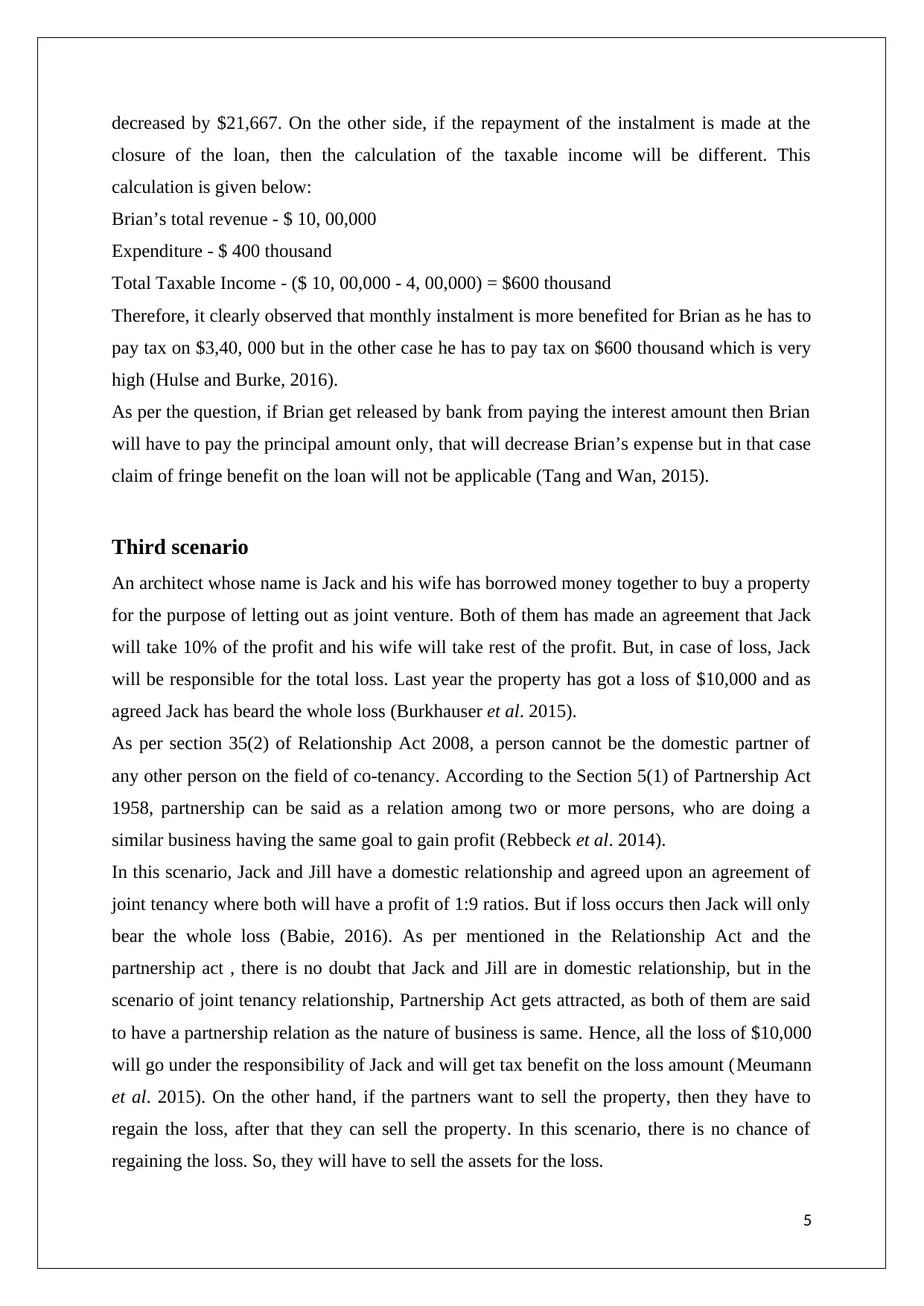
decreased by $21,667. On the other side, if the repayment of the instalment is made at the
closure of the loan, then the calculation of the taxable income will be different. This
calculation is given below:
Brian’s total revenue - $ 10, 00,000
Expenditure - $ 400 thousand
Total Taxable Income - ($ 10, 00,000 - 4, 00,000) = $600 thousand
Therefore, it clearly observed that monthly instalment is more benefited for Brian as he has to
pay tax on $3,40, 000 but in the other case he has to pay tax on $600 thousand which is very
high (Hulse and Burke, 2016).
As per the question, if Brian get released by bank from paying the interest amount then Brian
will have to pay the principal amount only, that will decrease Brian’s expense but in that case
claim of fringe benefit on the loan will not be applicable (Tang and Wan, 2015).
Third scenario
An architect whose name is Jack and his wife has borrowed money together to buy a property
for the purpose of letting out as joint venture. Both of them has made an agreement that Jack
will take 10% of the profit and his wife will take rest of the profit. But, in case of loss, Jack
will be responsible for the total loss. Last year the property has got a loss of $10,000 and as
agreed Jack has beard the whole loss (Burkhauser et al. 2015).
As per section 35(2) of Relationship Act 2008, a person cannot be the domestic partner of
any other person on the field of co-tenancy. According to the Section 5(1) of Partnership Act
1958, partnership can be said as a relation among two or more persons, who are doing a
similar business having the same goal to gain profit (Rebbeck et al. 2014).
In this scenario, Jack and Jill have a domestic relationship and agreed upon an agreement of
joint tenancy where both will have a profit of 1:9 ratios. But if loss occurs then Jack will only
bear the whole loss (Babie, 2016). As per mentioned in the Relationship Act and the
partnership act , there is no doubt that Jack and Jill are in domestic relationship, but in the
scenario of joint tenancy relationship, Partnership Act gets attracted, as both of them are said
to have a partnership relation as the nature of business is same. Hence, all the loss of $10,000
will go under the responsibility of Jack and will get tax benefit on the loss amount (Meumann
et al. 2015). On the other hand, if the partners want to sell the property, then they have to
regain the loss, after that they can sell the property. In this scenario, there is no chance of
regaining the loss. So, they will have to sell the assets for the loss.
5
closure of the loan, then the calculation of the taxable income will be different. This
calculation is given below:
Brian’s total revenue - $ 10, 00,000
Expenditure - $ 400 thousand
Total Taxable Income - ($ 10, 00,000 - 4, 00,000) = $600 thousand
Therefore, it clearly observed that monthly instalment is more benefited for Brian as he has to
pay tax on $3,40, 000 but in the other case he has to pay tax on $600 thousand which is very
high (Hulse and Burke, 2016).
As per the question, if Brian get released by bank from paying the interest amount then Brian
will have to pay the principal amount only, that will decrease Brian’s expense but in that case
claim of fringe benefit on the loan will not be applicable (Tang and Wan, 2015).
Third scenario
An architect whose name is Jack and his wife has borrowed money together to buy a property
for the purpose of letting out as joint venture. Both of them has made an agreement that Jack
will take 10% of the profit and his wife will take rest of the profit. But, in case of loss, Jack
will be responsible for the total loss. Last year the property has got a loss of $10,000 and as
agreed Jack has beard the whole loss (Burkhauser et al. 2015).
As per section 35(2) of Relationship Act 2008, a person cannot be the domestic partner of
any other person on the field of co-tenancy. According to the Section 5(1) of Partnership Act
1958, partnership can be said as a relation among two or more persons, who are doing a
similar business having the same goal to gain profit (Rebbeck et al. 2014).
In this scenario, Jack and Jill have a domestic relationship and agreed upon an agreement of
joint tenancy where both will have a profit of 1:9 ratios. But if loss occurs then Jack will only
bear the whole loss (Babie, 2016). As per mentioned in the Relationship Act and the
partnership act , there is no doubt that Jack and Jill are in domestic relationship, but in the
scenario of joint tenancy relationship, Partnership Act gets attracted, as both of them are said
to have a partnership relation as the nature of business is same. Hence, all the loss of $10,000
will go under the responsibility of Jack and will get tax benefit on the loss amount (Meumann
et al. 2015). On the other hand, if the partners want to sell the property, then they have to
regain the loss, after that they can sell the property. In this scenario, there is no chance of
regaining the loss. So, they will have to sell the assets for the loss.
5
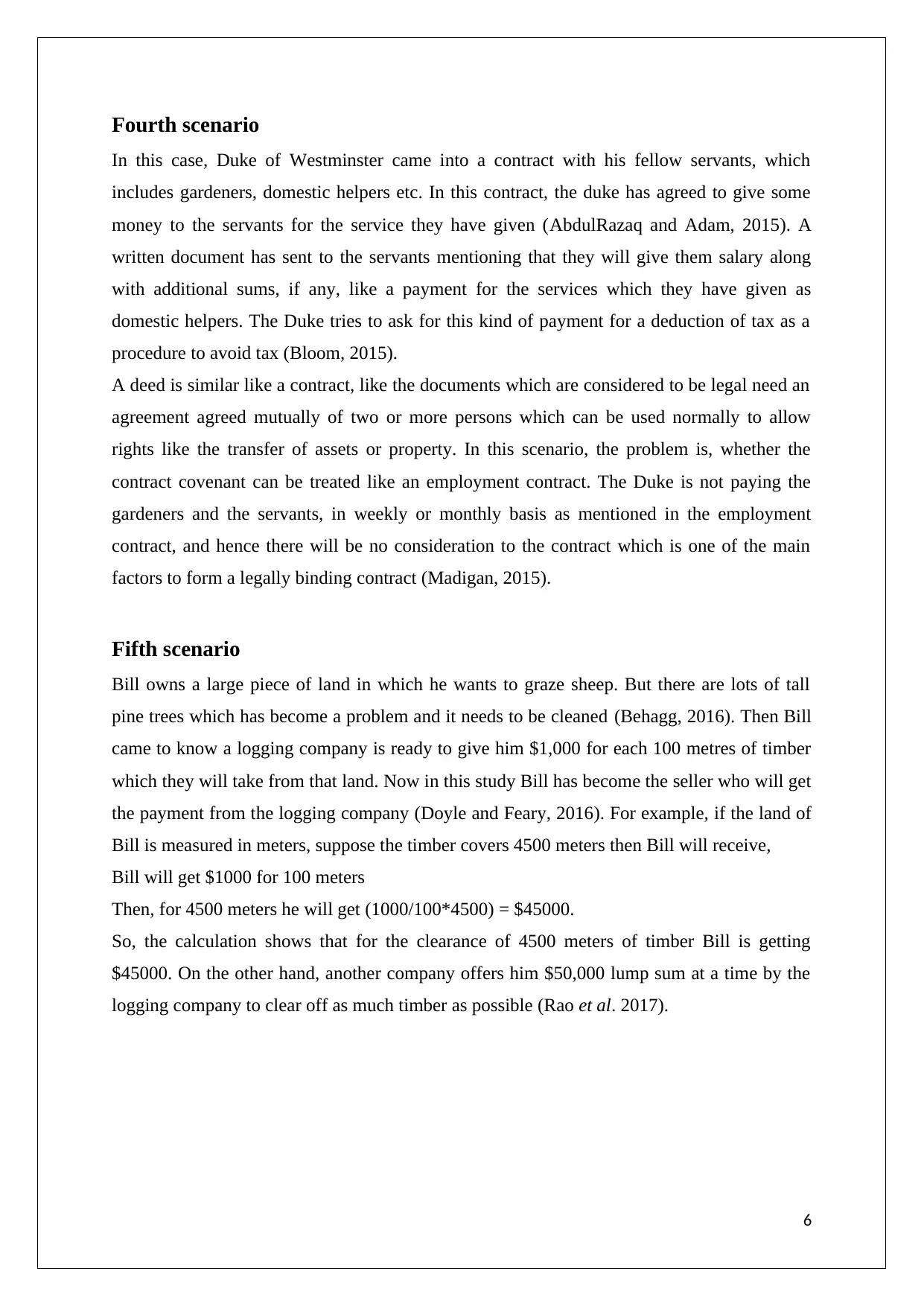
Fourth scenario
In this case, Duke of Westminster came into a contract with his fellow servants, which
includes gardeners, domestic helpers etc. In this contract, the duke has agreed to give some
money to the servants for the service they have given (AbdulRazaq and Adam, 2015). A
written document has sent to the servants mentioning that they will give them salary along
with additional sums, if any, like a payment for the services which they have given as
domestic helpers. The Duke tries to ask for this kind of payment for a deduction of tax as a
procedure to avoid tax (Bloom, 2015).
A deed is similar like a contract, like the documents which are considered to be legal need an
agreement agreed mutually of two or more persons which can be used normally to allow
rights like the transfer of assets or property. In this scenario, the problem is, whether the
contract covenant can be treated like an employment contract. The Duke is not paying the
gardeners and the servants, in weekly or monthly basis as mentioned in the employment
contract, and hence there will be no consideration to the contract which is one of the main
factors to form a legally binding contract (Madigan, 2015).
Fifth scenario
Bill owns a large piece of land in which he wants to graze sheep. But there are lots of tall
pine trees which has become a problem and it needs to be cleaned (Behagg, 2016). Then Bill
came to know a logging company is ready to give him $1,000 for each 100 metres of timber
which they will take from that land. Now in this study Bill has become the seller who will get
the payment from the logging company (Doyle and Feary, 2016). For example, if the land of
Bill is measured in meters, suppose the timber covers 4500 meters then Bill will receive,
Bill will get $1000 for 100 meters
Then, for 4500 meters he will get (1000/100*4500) = $45000.
So, the calculation shows that for the clearance of 4500 meters of timber Bill is getting
$45000. On the other hand, another company offers him $50,000 lump sum at a time by the
logging company to clear off as much timber as possible (Rao et al. 2017).
6
In this case, Duke of Westminster came into a contract with his fellow servants, which
includes gardeners, domestic helpers etc. In this contract, the duke has agreed to give some
money to the servants for the service they have given (AbdulRazaq and Adam, 2015). A
written document has sent to the servants mentioning that they will give them salary along
with additional sums, if any, like a payment for the services which they have given as
domestic helpers. The Duke tries to ask for this kind of payment for a deduction of tax as a
procedure to avoid tax (Bloom, 2015).
A deed is similar like a contract, like the documents which are considered to be legal need an
agreement agreed mutually of two or more persons which can be used normally to allow
rights like the transfer of assets or property. In this scenario, the problem is, whether the
contract covenant can be treated like an employment contract. The Duke is not paying the
gardeners and the servants, in weekly or monthly basis as mentioned in the employment
contract, and hence there will be no consideration to the contract which is one of the main
factors to form a legally binding contract (Madigan, 2015).
Fifth scenario
Bill owns a large piece of land in which he wants to graze sheep. But there are lots of tall
pine trees which has become a problem and it needs to be cleaned (Behagg, 2016). Then Bill
came to know a logging company is ready to give him $1,000 for each 100 metres of timber
which they will take from that land. Now in this study Bill has become the seller who will get
the payment from the logging company (Doyle and Feary, 2016). For example, if the land of
Bill is measured in meters, suppose the timber covers 4500 meters then Bill will receive,
Bill will get $1000 for 100 meters
Then, for 4500 meters he will get (1000/100*4500) = $45000.
So, the calculation shows that for the clearance of 4500 meters of timber Bill is getting
$45000. On the other hand, another company offers him $50,000 lump sum at a time by the
logging company to clear off as much timber as possible (Rao et al. 2017).
6
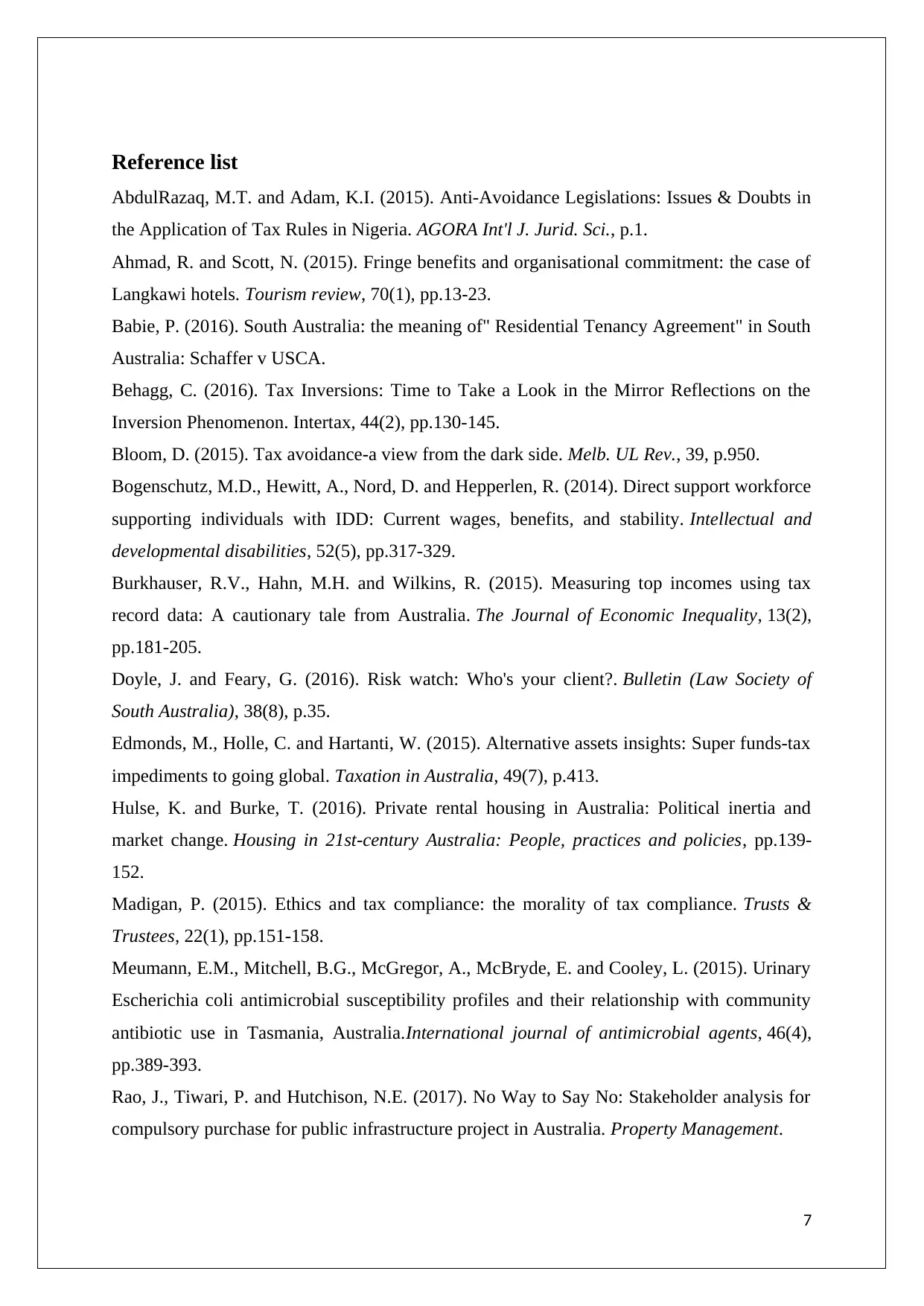
Reference list
AbdulRazaq, M.T. and Adam, K.I. (2015). Anti-Avoidance Legislations: Issues & Doubts in
the Application of Tax Rules in Nigeria. AGORA Int'l J. Jurid. Sci., p.1.
Ahmad, R. and Scott, N. (2015). Fringe benefits and organisational commitment: the case of
Langkawi hotels. Tourism review, 70(1), pp.13-23.
Babie, P. (2016). South Australia: the meaning of" Residential Tenancy Agreement" in South
Australia: Schaffer v USCA.
Behagg, C. (2016). Tax Inversions: Time to Take a Look in the Mirror Reflections on the
Inversion Phenomenon. Intertax, 44(2), pp.130-145.
Bloom, D. (2015). Tax avoidance-a view from the dark side. Melb. UL Rev., 39, p.950.
Bogenschutz, M.D., Hewitt, A., Nord, D. and Hepperlen, R. (2014). Direct support workforce
supporting individuals with IDD: Current wages, benefits, and stability. Intellectual and
developmental disabilities, 52(5), pp.317-329.
Burkhauser, R.V., Hahn, M.H. and Wilkins, R. (2015). Measuring top incomes using tax
record data: A cautionary tale from Australia. The Journal of Economic Inequality, 13(2),
pp.181-205.
Doyle, J. and Feary, G. (2016). Risk watch: Who's your client?. Bulletin (Law Society of
South Australia), 38(8), p.35.
Edmonds, M., Holle, C. and Hartanti, W. (2015). Alternative assets insights: Super funds-tax
impediments to going global. Taxation in Australia, 49(7), p.413.
Hulse, K. and Burke, T. (2016). Private rental housing in Australia: Political inertia and
market change. Housing in 21st-century Australia: People, practices and policies, pp.139-
152.
Madigan, P. (2015). Ethics and tax compliance: the morality of tax compliance. Trusts &
Trustees, 22(1), pp.151-158.
Meumann, E.M., Mitchell, B.G., McGregor, A., McBryde, E. and Cooley, L. (2015). Urinary
Escherichia coli antimicrobial susceptibility profiles and their relationship with community
antibiotic use in Tasmania, Australia.International journal of antimicrobial agents, 46(4),
pp.389-393.
Rao, J., Tiwari, P. and Hutchison, N.E. (2017). No Way to Say No: Stakeholder analysis for
compulsory purchase for public infrastructure project in Australia. Property Management.
7
AbdulRazaq, M.T. and Adam, K.I. (2015). Anti-Avoidance Legislations: Issues & Doubts in
the Application of Tax Rules in Nigeria. AGORA Int'l J. Jurid. Sci., p.1.
Ahmad, R. and Scott, N. (2015). Fringe benefits and organisational commitment: the case of
Langkawi hotels. Tourism review, 70(1), pp.13-23.
Babie, P. (2016). South Australia: the meaning of" Residential Tenancy Agreement" in South
Australia: Schaffer v USCA.
Behagg, C. (2016). Tax Inversions: Time to Take a Look in the Mirror Reflections on the
Inversion Phenomenon. Intertax, 44(2), pp.130-145.
Bloom, D. (2015). Tax avoidance-a view from the dark side. Melb. UL Rev., 39, p.950.
Bogenschutz, M.D., Hewitt, A., Nord, D. and Hepperlen, R. (2014). Direct support workforce
supporting individuals with IDD: Current wages, benefits, and stability. Intellectual and
developmental disabilities, 52(5), pp.317-329.
Burkhauser, R.V., Hahn, M.H. and Wilkins, R. (2015). Measuring top incomes using tax
record data: A cautionary tale from Australia. The Journal of Economic Inequality, 13(2),
pp.181-205.
Doyle, J. and Feary, G. (2016). Risk watch: Who's your client?. Bulletin (Law Society of
South Australia), 38(8), p.35.
Edmonds, M., Holle, C. and Hartanti, W. (2015). Alternative assets insights: Super funds-tax
impediments to going global. Taxation in Australia, 49(7), p.413.
Hulse, K. and Burke, T. (2016). Private rental housing in Australia: Political inertia and
market change. Housing in 21st-century Australia: People, practices and policies, pp.139-
152.
Madigan, P. (2015). Ethics and tax compliance: the morality of tax compliance. Trusts &
Trustees, 22(1), pp.151-158.
Meumann, E.M., Mitchell, B.G., McGregor, A., McBryde, E. and Cooley, L. (2015). Urinary
Escherichia coli antimicrobial susceptibility profiles and their relationship with community
antibiotic use in Tasmania, Australia.International journal of antimicrobial agents, 46(4),
pp.389-393.
Rao, J., Tiwari, P. and Hutchison, N.E. (2017). No Way to Say No: Stakeholder analysis for
compulsory purchase for public infrastructure project in Australia. Property Management.
7
Paraphrase This Document
Need a fresh take? Get an instant paraphrase of this document with our AI Paraphraser
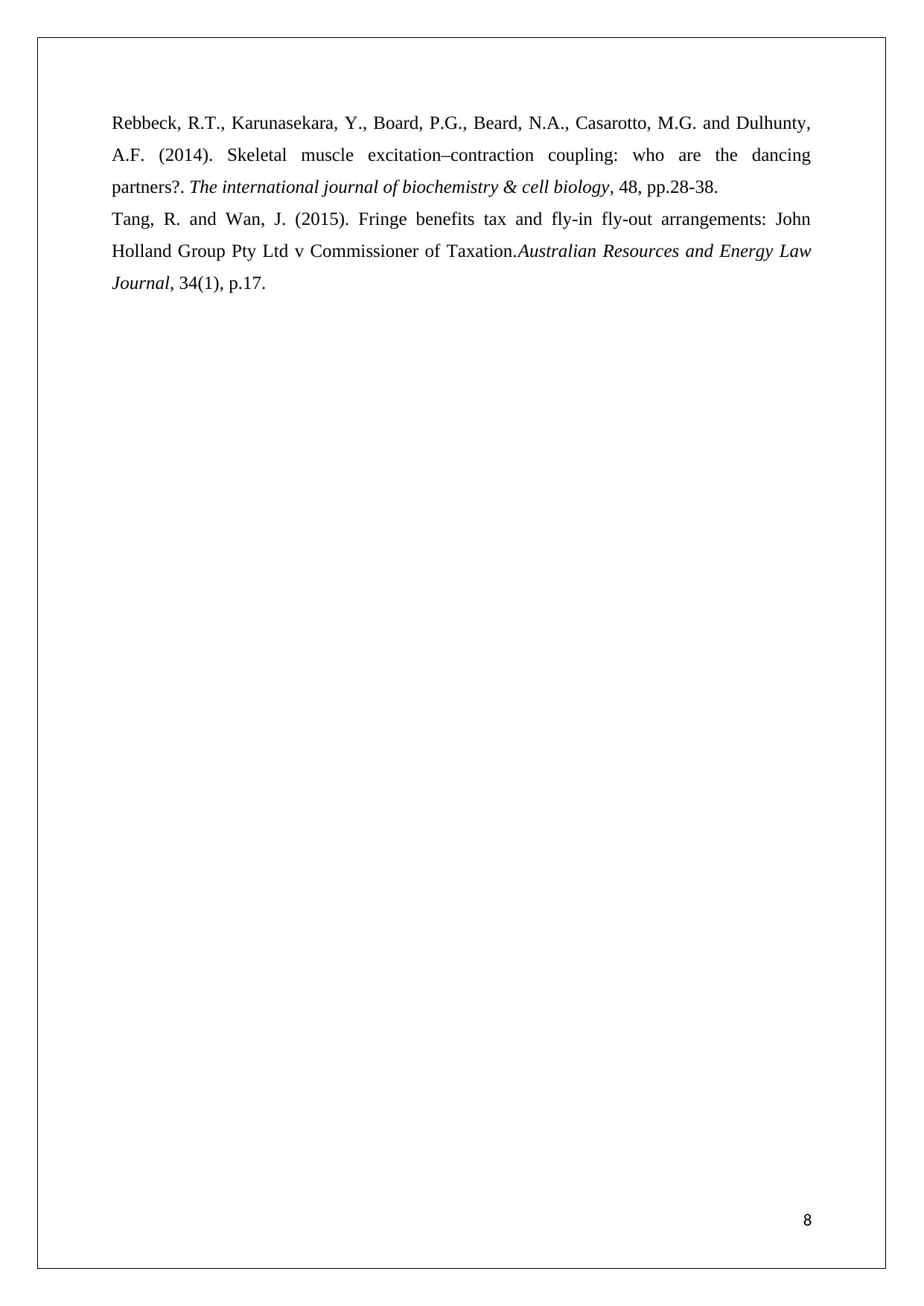
Rebbeck, R.T., Karunasekara, Y., Board, P.G., Beard, N.A., Casarotto, M.G. and Dulhunty,
A.F. (2014). Skeletal muscle excitation–contraction coupling: who are the dancing
partners?. The international journal of biochemistry & cell biology, 48, pp.28-38.
Tang, R. and Wan, J. (2015). Fringe benefits tax and fly-in fly-out arrangements: John
Holland Group Pty Ltd v Commissioner of Taxation.Australian Resources and Energy Law
Journal, 34(1), p.17.
8
A.F. (2014). Skeletal muscle excitation–contraction coupling: who are the dancing
partners?. The international journal of biochemistry & cell biology, 48, pp.28-38.
Tang, R. and Wan, J. (2015). Fringe benefits tax and fly-in fly-out arrangements: John
Holland Group Pty Ltd v Commissioner of Taxation.Australian Resources and Energy Law
Journal, 34(1), p.17.
8
1 out of 8
Related Documents
Your All-in-One AI-Powered Toolkit for Academic Success.
+13062052269
info@desklib.com
Available 24*7 on WhatsApp / Email
![[object Object]](/_next/static/media/star-bottom.7253800d.svg)
Unlock your academic potential
© 2024 | Zucol Services PVT LTD | All rights reserved.





